How to grow apricot from a seed in a pot at home
Apricot is a heat-loving tree that can fully grow and bear fruit only in the southern regions of our country. There are hybrids with increased cold resistance; they reproduce only vegetatively. However, apricot lovers grow an ordinary tree right at home in a pot, regardless of the region.
It is quite possible to propagate an apricot tree in a generative way, that is, to grow it from a seed. And with proper care, such a plant will also bear fruit. Read on to learn how to grow apricots in a pot at home.
Planting an apricot kernel
Before growing an apricot from a seed, it is worth understanding how advisable it is. After all, this method of propagating trees takes a lot of time.
During generative propagation, the plant often does not retain varietal characteristics. In this case, its fruits will be smaller than those of the mother tree.
Note! Wild apricots also have a sweet taste.
A tree grown from a seed will begin to bear fruit much later.than propagated vegetatively. On average, this occurs 3-5 years after planting.
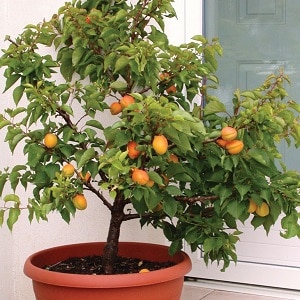 The generative method of reproduction has its advantages. These include high endurance and resistance of seedlings to negative environmental factors.
The generative method of reproduction has its advantages. These include high endurance and resistance of seedlings to negative environmental factors.
A tree from a seed is formed correctly, has a more beautiful and uniform crown. Gardeners note that often such plants have an unpronounced central trunk.Without much formation, they resemble a bush.
Apricot obtained from the seed is grown as a houseplant. at home or transplanted into open ground. It is not always possible to achieve fruiting in a pot.
Interesting things on the site:
A Beginner's Guide to Planting Apricots in the Fall
How to properly prune an apricot in the fall
How to cover an apricot for the winter and prepare it for cold weather
Selection of planting material
How to germinate an apricot kernel and get a high-quality plant with a tasty and abundant harvest? It is important to choose the right fruit. Pay attention to the following signs:
- Size. You should not take very large fruits for propagation. These are hybrids that will grow into trees without maternal characteristics. Preference is given to small apricots of local varieties. They have increased tolerance to negative environmental factors, are adapted to the climate of a particular region, and grow from them into plants with tasty fruits.
- Appearance. The apricot must have the correct shape. It is important that the skin has a uniform color, without spots, growths, rot, green areas and other signs of infection by infections and pests. It is important to use fruits that are as ripe as possible, or preferably slightly overripe.
- Taste. Preference should be given to fruits with sweet, juicy pulp. There is a high probability that such planting material will grow into a tree that produces crops with the same taste characteristics.
- Bone. Must have a hard shell with a uniform color without damage, spots or holes.
- Kernel taste. Gardeners recommend trying apricot kernels from the purchased batch. It should be sweetish.
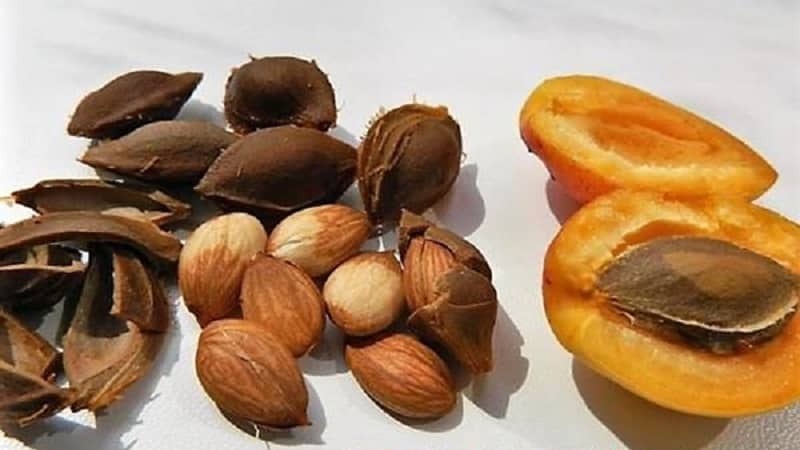
For cultivation, it is recommended to collect fruits directly from the tree. If this is not possible, you can use purchased ones.
Note! If you plan to transplant a bush from a pot into the ground, it is recommended to give preference to frost-resistant varieties. These include Edelweiss, Alyosha, Countess, etc.
Preparation of planting material
There are two ways to plant an apricot kernel. In the first case, it must be planted immediately as soon as it is removed from the fruit. It is important that by this time the seed does not have time to dry out. Otherwise it will not germinate. Gardeners call this method Michurinsky.
The second option involves preliminary stratification of seeds. It is closest to natural, since under natural conditions the seeds spend the winter in the ground and only then germinate. Planting material that has undergone such preparation has better germination. It is used in cases where the seed was not planted immediately after being separated from the pulp.
Step-by-step stratification instructions for beginners:
- Apricot kernels are soaked in a light pink solution of potassium permanganate for 2 hours. Then they are soaked in water at room temperature for another three days, changing the water daily.
- A layer of sand or sawdust is placed in the container. Bones are placed on them. They are covered with a layer of substrate on top, which is moistened with water.
- The container with the seeds is covered with a bag and put in the refrigerator or cellar. It is advisable to maintain a temperature of +2°C. It is important to ensure that the seeds do not dry out.

Under such conditions, apricot seeds germinate on average in three months. Before planting, they are placed in water and those that have sunk to the bottom are used.
Note! It is important to constantly check apricot pits for mold during stratification.
Preparing the soil and container
To ensure that the seeds germinate and the plants do not get sick or die, it is important to pay enough attention to preparing the soil and containers.
Seeds are planted individually in individual pots. Since the plant has a tap root system, the containers for planting are deep. In the first stages, it is convenient to use disposable half-liter cups or cut-off bottles. Plastic pots are also suitable.
Plants are replanted as they grow. To grow an adult plant at home, you will need a container with a volume of 10-30 liters. Ceramic pots are best for formed apricots. They allow air to pass through to the roots and absorb excess moisture, preventing both stagnation of liquid and drying out of the soil.
It is extremely important that when growing apricots, the liquid does not stagnate. Therefore, drainage holes are made in the bottom of the planting containers.
Apricot is not particularly demanding on soil composition.. Universal seedling soil is suitable for its cultivation. Prepare the soil mixture yourself. To do this take:
- garden soil – 10 kg;
- vermicompost – 1 l;
- vermiculite – 1 tbsp.;
- coconut substrate - 1 briquette.
Pour 2 liters of water into the coconut substrate and wait until it swells. Then all the ingredients are mixed. The resulting soil mixture is watered with a dark pink solution of potassium permanganate or a solution prepared from 10 liters of hot water and 1 tbsp. l. copper sulfate. Another option is to calcine the soil in the oven (a 5 cm layer is kept for half an hour at 70-90°C).
Containers are also disinfected by soaking in a dark pink solution of potassium permanganate or sterilizing with hot steam.
In addition to the container and soil, you will need drainage: small expanded clay, crushed stone, crushed ceramics, shell rock, etc.The drainage is also disinfected with boiling water or a dark pink solution of potassium permanganate.
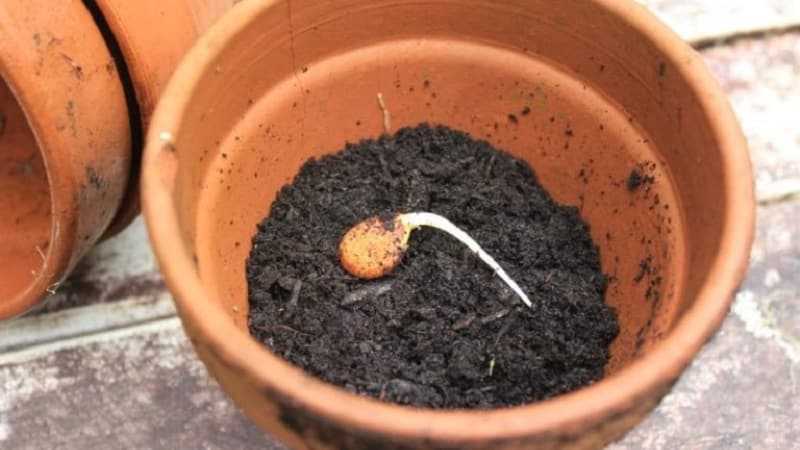
Landing algorithm
Even a beginner can handle planting an apricot kernel. If all conditions are met, the probability of germination is high.
How to plant an apricot pit at home in a pot:
- A layer of drainage 3-5 cm thick is poured into the bottom of the pot. The rest of the volume is filled with soil so that 2 cm remains free to the edge. The soil is compacted and watered with warm water.
- One seed is planted in each container with soil. They are placed in a pot with the spine down. The depth should be such that only the sprouted part is underground. If deeply buried, the seeds will not germinate.
- The soil is moistened with warm water. The containers with the crops are covered with film and placed in a warm place.
Read also:
Care during germination
During germination, it is important to provide proper care to apricots. Basic rules are presented in the list:
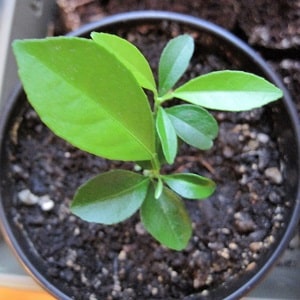 Every day, containers with crops are opened slightly and ventilated for 15 minutes. Condensation is wiped off the film.
Every day, containers with crops are opened slightly and ventilated for 15 minutes. Condensation is wiped off the film.- The soil is moistened as it dries. It is important to water it moderately so that the water does not stagnate. Otherwise, the bones will rot.
- When shoots appear, the duration of ventilation is gradually increased. When the ventilation time reaches 24 hours, the film is removed.
- Sprouted apricots should stand in a well-lit place - on a south or south-west windowsill. During the summer day, the windows are shaded with a translucent curtain to prevent the plants from getting burned.
Apricot care at home
The apricot tree can be grown as a houseplant.In this case pay special attention to care behind him:
- Watering. Water the tree as the soil dries. In summer, on average, 3-4 waterings per week will be needed. In winter, the soil is moistened once a week. For irrigation use water at room temperature. The soil is moistened in the morning or evening, when the sun is inactive.
- Spraying. Apricots are sprayed every two days with warm water from a spray bottle.
- Loosening. The soil in the pot is loosened at least 1-2 times a week. This is necessary to destroy the earthen crust, which interferes with normal root air exchange and causes fluid stagnation.
- Temperature. During the growing season, the optimal temperature for growing an apricot tree is +24…+26°C. At the end of autumn and winter, when the plant sheds its leaves, it is moved to a room with a temperature of 0 ... + 2 ° C, for example, to a glazed balcony or to a cellar.
- Lighting. In summer, if the tree grows on a south-facing window sill or balcony, it does not require additional lighting. In winter, too, if the tree is in the cold, additional light is not needed. If there is a phytolamp at home, it is used in early spring and autumn.
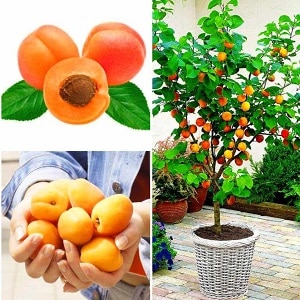 Feeding. In the first year of cultivation, the apricot tree is not fed. This negatively affects his development. From the second year they begin to apply fertilizing. The tree is fed first in the spring, when the buds swell, then in the summer (July) and autumn. Alternate mineral (superphosphate, potassium sulfate and ammonium nitrate) and organic (mullein or chicken manure solution) fertilizers.
Feeding. In the first year of cultivation, the apricot tree is not fed. This negatively affects his development. From the second year they begin to apply fertilizing. The tree is fed first in the spring, when the buds swell, then in the summer (July) and autumn. Alternate mineral (superphosphate, potassium sulfate and ammonium nitrate) and organic (mullein or chicken manure solution) fertilizers.- Formation. The apricot tree needs shaping. At home, the main stem is pinched when its height reaches 15-25 cm. First-order branches are pinched when their length reaches 20 cm.The 3-4 most developed and strong branches are left at one level, and the weak ones are removed. This is done with all shoots of the following orders. When the crown is formed, maintenance pruning and trimming are carried out to give the desired shape. The cut areas must be treated with garden varnish.
- Sanitary pruning. It is held at the end of each season. Remove old, weak, damaged branches. If there are areas on the trunk with cracked bark, they are covered with garden varnish.
- Bloom. When the tree blooms, it will need artificial pollination (if it is in the house at that time). To do this, pollen is transferred between flowers using a soft brush. To increase the chances of fruiting, it is advisable to have two apricot trees.
- Fruiting. In the first year, most of the ovaries are removed, leaving no more than two fruits on the plant. Then their number can be increased.
- Transfer. The tree is replanted as its root system fills the pot. It is transferred to a new container along with a lump of earth, removing only the drainage and the top layer. The missing volume is filled with new soil. In the first year, three transplants will be needed, then the pot is moved to a new container once a year. The formed plant is not replanted, but only the top layer of soil is replaced.
It is recommended to take apricots to the balcony in the warm season, loggia or garden, in a well-lit but protected from the wind place.
Advice! If apricots are taken outside in the summer, it is recommended to spray them with copper sulfate in early spring and after leaf fall to prevent diseases.
Is it possible to replant an apricot from a pot into open ground?
A seedling grown in a pot is also suitable for transplanting into open ground., provided that it is not younger than one year and not older than two years. The plant must have a well-formed root system, elastic, not dry branches and living axillary buds.
Before planting in a permanent place, they begin to take the tree in a pot outside, gradually accustoming it to new conditions and hardening it. They begin to do this at the beginning of spring.
For apricots, choose a well-lit and wind-protected area of the garden.. Groundwater should lie no closer than 2 m to the ground surface.
Tree planted in a hole that matches the size of the pot. The plant is moved into the hole along with a lump of earth, without deepening the root collar.
Conclusion
Apricot kernels have a high germination rate, so even a novice gardener can cope with their cultivation. A tree grown from seed planting material does not retain its parental characteristics, but even a wild apricot produces sweet and tasty fruits.
Apricot grown from the seed can be grown as a houseplant in a tub. In this case, he will need regular and proper care. In four years it will give its first harvest.